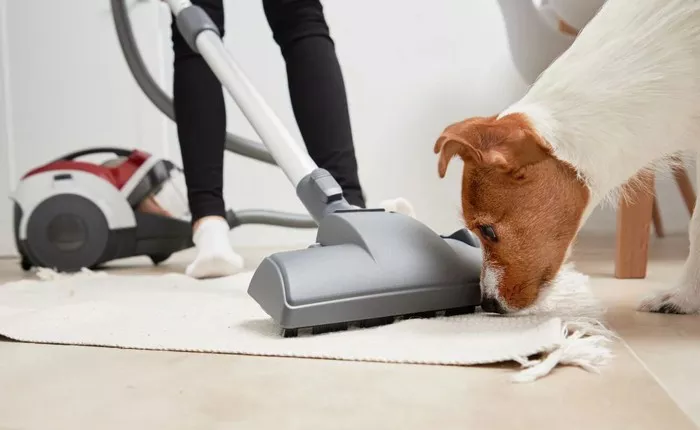Pet ownership brings immense joy and companionship, but it also comes with the perennial challenge of dealing with pet hair. For many, keeping a clean home while sharing it with a furry friend can feel like a never-ending battle. Pet hair finds its way onto furniture, carpets, clothes, and virtually every surface. This article delves into the effectiveness of vacuum cleaners in combating pet hair, exploring whether they can truly be the solution pet owners need.
See also: Why Does My Vacuum Have Weak Suction
Can Any Vacuum Handle Pet Hair?
Yes, vacuums can be used to clean pet hair. However, not all vacuums are created equal for this specific task. While a standard vacuum may suffice for general cleaning, tackling pet hair requires more specialized features to achieve the best results. The intricacies of pet hair removal mean that a vacuum must be equipped with the right combination of power, design, and filtration to be effective.
Pet hair has a tendency to weave itself into the fabric of carpets and upholstery, making it particularly stubborn to remove. This is why vacuums designed for pet hair often feature enhancements that standard vacuums lack. The right vacuum can transform a tedious chore into a manageable task, but choosing the wrong one can lead to frustration and subpar results.
Features of a Pet-Hair-Conquering Vacuum
Suction Power
Strong suction power is essential for any vacuum intended to tackle pet hair. Pet hair can be deeply embedded in carpets and fabrics, requiring a powerful motor to dislodge and capture it. A vacuum with inadequate suction will struggle to lift pet hair, leaving it behind and necessitating multiple passes over the same area.
High suction power ensures that even the most stubborn hairs are pulled from carpet fibers and upholstery. This is particularly important for homes with pets that shed heavily, as weaker vacuums may not be able to keep up with the volume of hair produced.
Brush Design
The design of the brush roll plays a critical role in a vacuum’s ability to handle pet hair. Standard brushes can become tangled with long pet hair, reducing their effectiveness and requiring frequent maintenance. Tangle-resistant brushes, often found in vacuums designed for pet owners, are engineered to minimize this issue.
These brushes typically feature a combination of bristles and rubber fins that work together to lift and separate pet hair from surfaces. This design not only improves the vacuum’s efficiency in picking up hair but also reduces the need for manual cleaning of the brush roll.
Filtration
Effective filtration is another crucial feature for a vacuum designed to handle pet hair. Pet dander, which consists of tiny skin flakes shed by animals, can trigger allergies and respiratory issues. A vacuum with poor filtration may release these particles back into the air, exacerbating indoor air quality problems.
HEPA (High-Efficiency Particulate Air) filters are particularly effective at trapping small particles, including pet dander. A vacuum equipped with a HEPA filter ensures that both hair and dander are contained within the vacuum, improving overall air quality and making the home environment healthier for allergy sufferers.
See also: Why Does My Vacuum Lose Suction
Attachments
Attachments can significantly enhance a vacuum’s ability to clean pet hair from various surfaces. Upholstery tools, for instance, are designed to clean furniture and other fabric-covered areas where pet hair tends to accumulate. These tools often feature small, powerful brush rolls or rubberized surfaces that attract and lift hair.
Crevice tools are another valuable attachment, allowing the vacuum to reach into tight spaces and corners where pet hair can gather. Other attachments, such as motorized pet hair tools, are specifically designed to increase the vacuum’s efficiency in picking up hair from carpets and upholstery.
Beyond the Vacuum
While a good vacuum cleaner is indispensable for managing pet hair, there are additional strategies that can help keep pet hair under control. Regularly brushing your pet is one of the most effective ways to reduce shedding. By removing loose hair before it falls onto surfaces, you can significantly decrease the amount of hair that needs to be vacuumed.
Different pets have varying grooming needs, so it’s important to use the right brush for your pet’s coat type. For example, a slicker brush is effective for long-haired breeds, while a rubber curry brush works well for short-haired pets. Regular grooming sessions can also be a bonding activity, improving your pet’s coat health and reducing overall shedding.
Another strategy is to use washable covers on furniture. These covers can be easily removed and cleaned, preventing hair from embedding itself in upholstery. Similarly, regularly washing pet bedding and using lint rollers or pet hair removal tools can help maintain a cleaner home environment.
Conclusion
In summary, vacuum cleaners can indeed be excellent tools for removing pet hair, but it is crucial to choose one with the right features for the job. High suction power, tangle-resistant brush designs, effective filtration systems, and specialized attachments are all key components of a pet-hair-conquering vacuum.
While the right vacuum can make a significant difference, combining its use with regular pet grooming and other hair control strategies will yield the best results. Pet owners should consider researching and investing in vacuums specifically designed for pet hair to make their cleaning efforts more efficient and effective. By doing so, they can enjoy the company of their furry friends without the constant struggle of dealing with pet hair.

